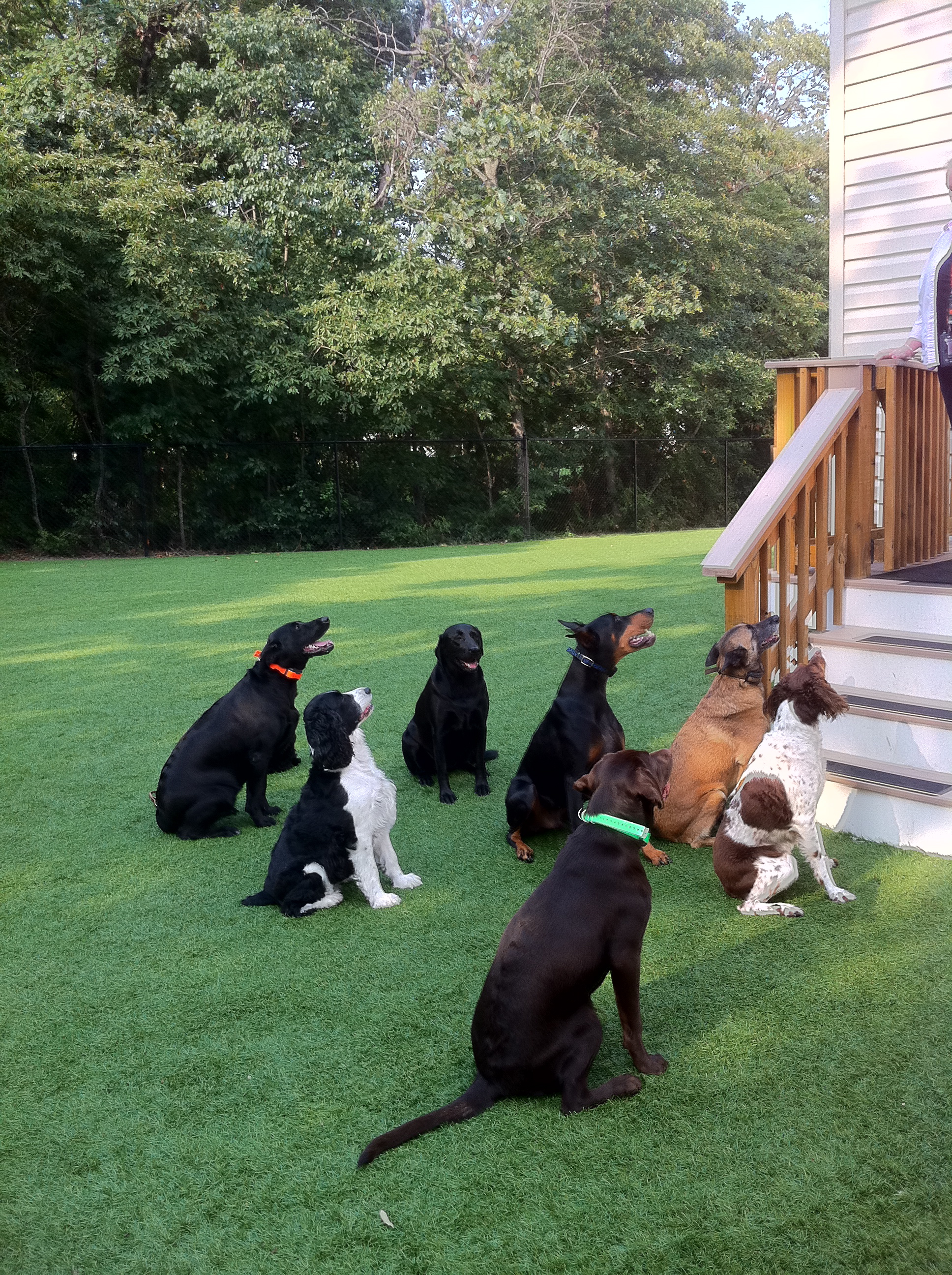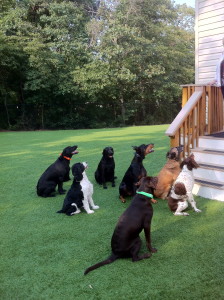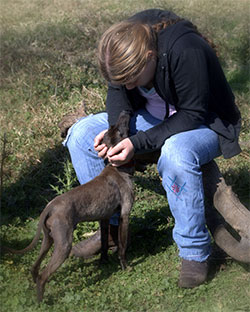Author Archive for Ann Greene
Certified Professional Dog training on Cape Cod, Massachusetts
Having a well trained and well mannered dog not only saves you time and money from potential incidents, your quality of life will improve, not to mention that it will make your dog happy! People will stop you on the street and comment on your well-behaved dog.
Going out of town and need to board you dog? Well, why don’t you get more bang for your buck and enroll in a Board and Train Program where your dog will become part of our family! Your dog will have the opportunity to work on their socialization, behavior and basic obedience skills, while having professionally supervised fun at the same time with other dogs. Dog’s are pack animals and thrive in a good healthy pack environment that is provided during a Board and Train program. There are rules, boundaries and limitations, but there is also fun at the beach, exercise and confidence building on our agility obstacle course, healthy snack n’ learn breaks, and cuddle time in the family room at the end of the day. Kenneling in a traditional commercial kennel is very stressful – not to mention the many unnecessary vaccines and dangerous topical medications they require in order to board. Typically, dogs are returned to owners with an overwhelming dog smell (unless you pay extra for the “go home bath”); separation anxiety, Lethargy (due to the excessive barking in a commercial kennel) and may have picked up some bad habits as well.
Our ‘in-home” Board and Train dog training program allows us dog trainer(s) to treat your furry family member like our own, and provide the personal love and attention that your family member deserves. We treat our furry guests the way we would want our own dogs treated – and we would not settle for less than the best.
Board and Train programs jump-start the training process and provide the solid foundation that will assist you in getting your dog to become “that well-mannered dog” that is regularly complemented on its good behavior and manners. The trainer(s) will start the extensive immersion training program to teach your dog to master basic obedience commands with at a distance, with distractions, and for a longer duration than previously thought possible. The Board and Train is a total immersion program with multiple customized training sessions each day to reinforce the learning process.
A Tail Above Dog Training offers quality Board and Train programs in Massachusetts, where we teach your dog and then train you when its time for them to return home! As an added bonus, during your dogs board and train program, we keep you updated with photos on our Facebook page to lessen your anxiety and to keep you updated on your dog’s progress. You, your family, and your co-workers will marvel at witnessing the transformation your dog will experience, and your heart will be warmed when you see how happy your dog is while in training.
Bringing a new puppy home is an event that requires a bit of planning. Imagine that you are about to bring a two-year-old child into your house. He’ll be curious, active, perhaps a bit shy and overwhelmed by noise and action, and easily overtired. Are you ready for the challenges that a new puppy brings into your home? Here are some things to be aware of, and some tips to help you prepare.
Your Puppy Is Just a Baby
Young puppies are easily overwhelmed. Here are some tips for those first few days:
- Keep your puppy’s environment as calm as possible. Excited kids, other pets and household chaos can overwhelm your little puppy and cause anxiety.
- Recognize the signs of naptime. Puppies, like babies, need frequent naps. Learn to recognize the signs that your puppy is becoming overtired, and whisk him into a quiet room (or his crate) for a break.
- Your puppy’s appetite might be affected by the transition. Don’t worry too much if he doesn’t eat a lot the first day. If he struggles for longer than a few days, see your veterinarian.
Keep Puppy Safe
You’ll want to puppy-proof your house, both to protect your pup and to protect your belongings!
- Install baby gates at the top of stairs. Curious puppies can take a tumble down stairs, with bad results.
- Get on your hands and knees! Crawl around and look at your home from a puppy’s viewpoint. See any interesting dangling cords or tablecloths? Secure them now, or risk Puppy pulling something over on top of himself.
- Educate kids in advance. Teach children how to treat your puppy before he arrives. No ear pulling, tail pulling or hitting allowed! Show kids the right way to hold the puppy so that he feels secure and is safe.
- Remove any poisonous plants from your home, or place them high enough that your puppy could never reach them.
- Be aware of choking hazards. Some dog treats are not meant for small puppies. Small toys can be swallowed.
The First Night
If you’ve adopted a very young puppy, he may have a difficult time being away from his mom and litter mates. Use the tips to keep your puppy from crying all night.
- Take a small blanket or towel to his birth home a few days before picking him up. Ask the owners to put it where mom sleeps, so it will smell like her. Then tuck it into your puppy’s new bed at home, where the smell will be reassuring.
- Plan to have your puppy sleep near you, at least for the first few nights. Place his crate or bed near yours.
- If your puppy cries or whines, give him gentle reassurance, but be firm. The middle of the night is not the time for a game of tug, unless you want to form some very bad habits.
- Consider a “heartbeat” toy. Your local pet store carries a variety of stuffed puppy toys that sound like a mother dog’s heartbeat.
Adopting a puppy is a big committment. Dogs have an average lifespan of 11 years, so you want to make sure you’re in it for the long haul. Puppies are adorable, but they’re also a lot of work. Animal shelters are full of one-year-old dogs that have been abandoned because their owners just didn’t have time for them, or didn’t take the responsibility from the beginning to train them. Don’t add to the population of abandoned dogs—make sure you’re ready for a puppy before you get one.
Cost
Sure, puppies are probably less expensive to raise than children, but they do still require a financial committment. Puppy expenses include:
- Veterinary Bills. Your puppy needs regular vet checkups and immunizations. He may have injuries or illnesses that require attention as well.
- Food. Big dogs eat a lot; little dogs not as much. Just like humans, dogs deserve healthy, nutritious food. While you don’t need to spend loads of money on expensive, packaged food, quality food should be an expected expense.
- Daycare. If your puppy will be an “only dog,” and you’re gone during the day, he might do well in puppy daycare. He’ll get a chance to socialize with other dogs and won’t chew your couch while you’re at work. Daycare can cost several hundred dollars per month, however.
- Toys, Treats and Chews. Puppies and adult dogs need toys to keep them active and engaged. Toys needn’t be expensive, but they do cost a little.
- Training. A well-trained puppy is a well-loved puppy! Training is worth every penny you’ll spend, but you’ll want to plan for the expense before taking on a new pup.
- Grooming. Some breeds don’t require professional grooming at all; others require regular grooming appointments
Time
- Play Time. Puppies need lots and lots of play time in order to get rid of all that wiggly puppy energy!
- Bonding Time. Your puppy needs to be around you a lot, especially in the beginning, to create that dog/owner bond that will last a lifetime. Be prepared to take your puppy with you on errands, for walks, and just into different areas of the house while you complete chores.
- Exercise Time. Puppies and grown dogs need exercise. Every day. Unless your dog is sick, he will need to be walked daily, and should have other forms of exercise frequently.
Patience
Puppies are babies, and they make messes and mistakes. You’ll need a lot of patience during the first year of your puppy’s life.
- Potty Training. Your puppy is going to make a few messes in the house. Unless he comes to you already trained, he is going to pee on your carpet and perhaps poop in a corner a time or two.
- Chewing. Your puppy has a natural inclination to chew. Though there are many things you can do to train him, it’s likely that he’ll damage some of your personal property.
- Crying, Whining, Barking. All of these annoying behaviors can be eased with proper training, but your puppy is apt to whine, cry or bark in those early months.
- You might be making an emotional decision based on a warm, fuzzy notion of a puppy with a red bow around his neck, snuggled in front a fire with chestnuts roasting. A puppy is not a present—he’s a family member.
- Christmas is a stressful, busy time at your house. A new puppy needs a quiet, calm environment for those first few weeks while he adjusts to life at his new home.
- Christmas is a dangerous time for puppies. Children’s toys, poisonous plants and human food, wrappings and Christmas lights are all potential hazards to your new puppy.
A Word About Christmas Puppies
Christmas time is a popular time to bring home a new puppy. Veterinarians and dog associations recommend against this, because:
One of the most important commands is to teach a dog to come when called
when your dog is approaching a dangerous situation, an oncoming car or a dangerous animal, for instance, coming when called can save his life.
INVITE your dog to come to you
Why would your dog want to come to you if you are screaming “COME!#%$^#!!!” angrily, at the top of your lungs – or worse – chasing after him WHILE doing so. That may be a little scary, don’t you think? Also, don’t ask your dog to come to you that may sound like you are on the fence. Many people do not realize that they have added a question mark after the command “Come”. There is middle ground. We like to train YOU to command your dog to Come as if you are inviting him or her to a party.
Think of this from your dog’s perspective.
Who would YOU rather go to – the crazy maniac chasing you and screaming COME!!!!! At the top of their lungs, the quiet unsure owner who issues a “come?” as if they don’t really mean and sound unsure, or the fun happy owner who gives an enthusiastic “COME…..atta boy…..”…..same way they would say “hey, we’re having a great barbeque on Saturday – why don’t you COME?”. Think about it. MAKE IT FUN. Your dog should WANT to come to you.
The first thing to think about when teaching your dog to come is his motivation for doing so. He certainly loves your approval.. But if he’s off-leash, he’s also loving whatever he’s doing when you call. If you have first established yourself as your dogs leader, this won’t be a problem. How do you do that? Well, for one thing, your dog should not be off leash outside until you are first able to get him or her off leash INSIDE! Well, how do I get my dog to come to me when I call him or her inside, you ask. Read on.
Training
In the beginning phase of teaching this command, you’ll want to be sure your dog is attached to a leash or a long line. Invite your dog to Come. If your dog decides not to, you are in a position to HELP the dog, because you are at the other end of the leash. What are you teaching the dog? You are teaching the dog that you are going to follow through every single time you ask the dog to come. Hire a Certified Professional Dog Trainer to help you with to train all the obedience commands, so you have a common language with your dog. The other benefit to hiring a professional, is to learn proper leash handling techniques – it makes ALL the difference in training your dog to come when called, to Sit, to stop jumping etc. Timing is also critical, is your timing right?
Praise and Love
When your dog comes to you, you’ll praise him. Your dog loves your approval; make sure to let him know that he’s done a really great job by coming when called. You want to be sure you are using the RIGHT level of praise for YOUR dog. Again, a Certified Professional Trainer can help you get the best from your dog.
The steps to training the “come” command:
- Start by putting your dog in an area where he is very close to you, and on a leash or long line (a small room or hallway would be great, for instance). Put squirmy puppies on a long leash. Try to find a spot without lots of interesting distractions.
- Let your dog wander away from you.
- Call him to you, using a specific command you’ve chosen. You can say “Come!” or, “Here!” or any word you’d like, as long as you’re consistent.
- Keep calling until the dog comes to you.
- When he comes, have him “sit” then praise him.
- Repeat until he figures out that you will help him each time in the event he chooses to ignore you. (this shouldn’t take long!)
- For puppies, reinforce with treats, and gradually begin to give less treats. You might give a treat three times in a row, then no treat (but still lots of praise). Work on this until you give a treat only once in awhile.
Realize that learning this command will take several sessions. Gradually move from a distraction-free, enclosed space to a space with higher distractions. Always give lots of praise.
Hi Folks,
The temps have dipped way down, and it is VERY cold outside. Please think of Fido if you decide to go for a long walk or run. Folks may have put salt down on the sidewalks and roads. This can have a very bad effect on a dog’s paws. Be sure to rinse off your dogs paws when you return from your walk.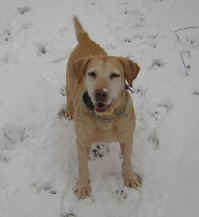
Also, remember that your dog does walk on those paws – so if you are walking on snow or ice, your dogs paws can quickly become uncomfortable and frozen.
Watch as Certified Professional Dog Trainer, Ann Greene, uses a camera to monitor the 4 month old puppy she is training, Levi.
Ann wants to see how long he would remain on his “PLACE”. The Place Command is basically a crate without walls. Nobody trains it better than Ann!
Watch this puppy – he is happy and well behaved. All this at FOUR MONTHS of age.
Call A Tail Above Dog Training in Massachusetts to help you get started on building a better relationship with YOUR dog!
10 tips: Keeping your pets safe during ‘Dog Days of Winter’
Pet owners should keep “man’s best friend” in mind as well when it comes to braving the “Dog Days of Winter”. Extreme cold temperatures can be very dangerous for dogs outside and below are 10 tips for dog owners to ensure their pets are safe and  comfortable during long periods of extreme cold weather from a Metro Detroit-based dog rescue group.
comfortable during long periods of extreme cold weather from a Metro Detroit-based dog rescue group.
Doggie Fitness & Relief
During cold weather months, pet owners need to pay more attention to the time spent outside. Pet owners should limit their dogs’ time outside to reduce exposure. When outdoors, dress your dog with an insulated vest, sweater and doggie boots to protect their paws and core.
Nutrition & Adequate Hydration
Dogs that spend most of their time outdoors may need more calories to maintain their energy level in cold weather. Always check with your vet regarding all changes to your dog’s diet. It’s also important to make sure your dog has adequate water outside. Keep it fresh and in a plastic bowl (avoid metal) to prevent it from freezing – contrary to popular belief dogs cannot break ice in a water bowl and you do not want them licking ice or eating snow as a way to hydrate. Snow and ice in an urban setting can be filled with toxins from salt and other antifreeze products that are harmful to your dog’s digestive system.
If Lost Can Find
Always keep a collar on your dog and consider having your pet identified with a microchip. If your dog gets loose, lost or disoriented in cold weather with an ID collar and microchip you will have a fighting chance if your dog is found and can be returned home.
In The Dog House
If your dog must spend significant time outdoors, PLEASE provide adequate sheltering and bedding. Keeping your dog tied up to the porch, stairs, fence or a tree is not humane. A good way to keep your dog secure and comfortable is in a doghouse – raised off the ground with a roof to shed away the elements. In the doghouse, make sure you keep enough straw (avoid hay) to provide a nice bedding for your dog. Straw keeps mold and bacteria down and is a great insulator in the house.
Pet Safety & Winter Hazard
In extreme cold weather, believe-it-or-not, your dog can get frostbite on their paw-pads. Prolonged contact with frozen ground surfaces such as concrete and asphalt can be dangerous for dogs. Be aware of harmful substances such as road salt and other ice melting antifreeze products that can get lodged in between paws causing an irritation or chemical burn. Always wipe down your dog’s paws after spending time outside – this will prevent them from digesting any toxic materials when they decide to lick and clean themselves.
Don’t Leave Dog in Car
Don’t leave your dog in the car unattended for any time during extreme weather periods – cold or hot. Just because most dogs have fur does not mean they can stand near arctic or below temperatures.
Groom Regularly
Your pet needs a well-groomed coat to keep properly insulated. Short or coarse-haired dogs might get extra cold so consider a sweater or a coat. Long-haired dogs should have their paw hair trimmed to ease in cleaning and snow removal.
House Warming Party
Carefully keep pets warm inside and away from drafts while inside. Also, Keep portable heaters out of reach and make sure all fireplaces have adequate screening. And, of course, never leave your pet alone with an unattended fire.
Puppy Power
Puppies do not tolerate the cold as well as adult dogs and may be difficult to housebreak during the winter. If necessary, paper-train your puppy inside if he or she appears to be sensitive to the weather.
And The Best Tip of All!
Keep your dogs with you at all times during the winter months. The best prescription for the Dog Days of Winter is to keep your dog inside with you and your family. The happiest dogs are those who are taken out frequently for walks and exercise but kept inside the rest of the time with you. Be happy, be kind, be humane.
If I haven’t been able to talk you out of getting a new puppy or dog for Christmas yet, then please at least do this:
Hire a trainer to help you get your new family settled in much easier.
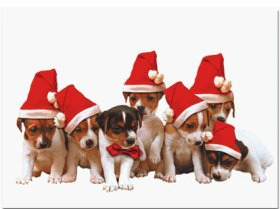 The holidays are NOT the best time to add a new furry friend to your home. Why? Well, for starters – STRESS!!
The holidays are NOT the best time to add a new furry friend to your home. Why? Well, for starters – STRESS!!
It is quite stressful for a dog to move into a new living situation. Adding a dog to your home during a time that is a very busy time for families is not in the best interest of your new dog – or you!
How about getting a picture of a local shelter, putting that in an envelope, put that in a box, wrap that up … and let the kids know you’ll be going together to all pick out your newest family member AFTER the holidays have settled down?
Just a thought.
Too late?
CALL A TRAINER. That will be the best gift you could give yourselves – AND your new furry family member.
Hi All,
Well, I don’t know about you…but we are VERY excited here to watch the dog show tonight.
Who is our pick to win?
WELL, the final three group winners have yet to be decided, and one of them is the Working Group. You all know how I LOVE LOVE LOVE Dobies. So…I am really hoping that Protocol’s Veni Vidi Vici (Fifi – or, her other nickname: The Fifinator!) wins Working Group AND wins the whole show!
I love my Belgian Malinois as well, and was sad that a Mal did not win the Herding Group last night.
If Fifi wins working group – that’s my pick! Otherwise, I just might root for GCH Banana Joe V Tani Kazari (“Joe”) – the Affenpinscher.
Either way, I think it will be a “pinscher” that wins!
Copyright © 2025 All Rights Reserved
We are open! Offering PRIVATE Sessions, BOARD & TRAIN Programs and online TRAINING options. Call now (617) 448-2455 Learn more


